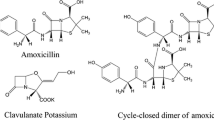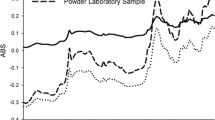Abstract
The purpose of this work was to demonstrate how multivariate figures of merit, in conjunction with accuracy and precision statistics, can be used to evaluate the performance of near-infrared reflectance and transmittance spectroscopy for the nondestructive chemical quantification of intact pharmaceutical compacts. A total of 174 four-component compacts were produced at five compaction pressures following a fully balanced quaternary design. Near-infrared spectra were measured in both reflectance and transmittance modes. Partial least-squares regression was used to model spectroscopic response, and net analyte signal theory was used to generate the figures of merit. It was discovered that sample positioning variation more negatively impacted the performance (analytical sensitivity, S/N ratio, limit of detection) of the transmittance method. Process analytical technology implementation teams should consider these aspects during technology selection, method development, and validation.






Similar content being viewed by others
References
US Food and Drug Administration (FDA). (2004) PAT—a framework for innovative pharmaceutical development, manufacturing, and quality assurance. Available at: http://www.fda.gov/CDER/GUIDANCE/6419fnl.pdf.
Martens H, Naes T. Multivariate calibration. New York: Wiley; 1989.
Ellekjaer MR, Isaksson T. Assessment of maximum cooking temperatures in previously heat treated beef. Part 1: near infrared spectroscopy. J Sci Food Agric. 1992;59:335–43.
Jeon KJ, Hwang ID, Hahn S, Yoon G. Comparison between transmittance and reflectance measurements in glucose determination using near infrared spectroscopy. J Biomed Opt. 2006;11:14022–8.
Borjesson T, Stenberg B, Schnurer J. Near-infrared spectroscopy for estimation of ergosterol content in barley: A comparison between reflectance and transmittance techniques. Cereal Chem. 2007;84:231–6.
Varadi M, Hruschka W, Norris KH. Investigation into the applicability of diffuse reflectance and transmittance technology to tobacco analysis. Acta Alimentaria. 1992;21:95–106.
Ellekjaer MR, Hildrum KI, Naes T, Isaksson T. Determination of the sodium chloride content of sausages by near-infrared spectroscopy. J Near Infrared Spectrosc. 1993;1:65–75.
McKenna D. Measuring moisture in cheese by near infrared absorption spectroscopy. J AOAC Int. 2001;84:623–8.
Thygesen LG. Determination of dry matter content and basic density of Norway spruce by near infrared reflectance and transmittance spectroscopy. J Near Infrared Spectrosc. 1994;2:127–35.
Mitsumoto M, Maeda S, Mitsuhashi T, Ozawa S. Near-infrared spectroscopy determination of physical and chemical characteristics in beef cuts. J Food Sci. 1991;56:1493–6.
Segtnan VH, Isaksson T. Evaluating near infrared techniques for quantitative analysis of carbohydrates in fruit juice model systems. J Near Infrared Spectrosc. 2000;8:109–16.
Baye TM, Pearson TC, Settles AM. Development of a calibration to predict maize seed composition using single kernel near infrared spectroscopy. J Cereal Sci. 2006;43:236–43.
Kays SE, Shimizu N, Barton FE II, Ohtsubo K. Near-infrared transmission and reflectance spectroscopy for the determination of dietary fiber in barley cultivars. Crop Sci. 2005;45:2307–11.
Scholz E, Prieto-Linde ML, Gergely S, Salgo A, Johansson E. Possibilities of using near infrared reflectance/transmittance spectroscopy for determination of polymeric protein in wheat. J Sci Food Agric. 2007;87:1523–32.
Chen H, Marks BP. Evaluating previous thermal treatment of chicken patties by visible/near-infrared spectroscopy. J Food Sci. 1997;62:753–756, 780.
Isaksson T, Miller CE, Naes T. Nondestructive NIR and NIT determination of protein, fat, and water in plastic-wrapped, homogenized meat. Appl Spectrosc. 1992;46:1685–94.
Rodriguez-Saona LE, Fry FS, McLaughlin MA, Calvey EM. Rapid analysis of sugars in fruit juices by FT-NIR spectroscopy. CarbohydR Res. 2001;336:63–74.
Otsuka M, Tanabe H, Osaki K, Otsuka KYO. Chemoinformetrical evaluation of dissolution property of indomethacin tablets by near-infrared spectroscopy. J Pharm Sci. 2007;96:788–801.
Schneider RC, Kovar K-A. Analysis of ecstasy tablets: Comparison of reflectance and transmittance near infrared spectroscopy. Forensic Sci Int. 2003;134:187–95.
Gottfries J, Depui H, Fransson M, Jongeneelen M, Josefson M, Langkilde FW, Witte DT. Vibrational spectrometry for the assessment of active substance in metroprolol tablets: A comparison between transmission and diffuse reflectance near-infrared spectrometry. J Pharmaceut Biomed. 1996;14:1495–503.
Thosar SS, Forbess RA, Ebube NK, Chen Y, Rubinovitz RL, Kemper MS, Reier GE, Wheatley TA, Shukla AJ. A comparison of reflectance and transmittance near-infrared spectroscopic techniques in determining drug content in intact tablets. Pharm Dev Technol. 2001;6:19–29.
Merckle P, Kovar K-A. Assay of effervescent tablets by near-infrared spectroscopy in transmittance and reflectance mode: Acetylsalicylic acid in mono and combination formulations. J Pharmaceut Biomed. 1998;17:365–74.
Williams PC, Sobering DC. Comparison of commercial near infrared transmittance and reflectance instruments for analysis of whole grains and seeds. J Near Infrared Spectrosc. 1993;1:25–32.
Cogdill RP, Anderson CA, Delgado-Lopez M, Molseed D, Chisholm R, Bolton R, Herket T, Afnan AM, Drennen III JK. Process analytical technology case study part I: feasibility studies for quantitative near-infrared method development. AAPS PharmSciTech. 2005;6, Article 37.
Morgan DR. Spectral absorption pattern detection and estimation. I. Analytical techniques. Appl Spectrosc. 1977;31:404–15.
Lorber A. Error propagation and figures of merit for quantification by solving matrix equations. Anal Chem. 1986;58:1167–72.
Olivieri AC, Faber NM, Ferre J, Boque R, Kalivas JH, Mark H. Uncertainty estimation and figures of merit for multivariate calibration. Pure Appl Chem. 2006;78:633–61.
Lorber A, Faber K, Kowalski BR. Net analyte signal calculation in multivariate calibration. Anal Chem. 1997;69:1620–6.
Brown CD. Discordance between net analyte signal theory and practical multivariate calibration. Anal Chem. 2004;76:4364–73.
Boelens HF, Kok WT, de Noord OE, Smilde AK. Performance optimization of spectroscopic process analyzers. Anal Chem. 2004;76:2656–63.
Ferre J, Brown SD, Rius FX. Improved calculation of the net analyte signal in inverse multivariate calibration. J Chemometr. 2001;15:537–53.
Bro R, Andersen CM. Theory of net analyte signal vectors in inverse regression. J Chemometr. 2004;17:646–52.
Goicoechea HC, Olivieri AC. Chemometric assisted simultaneous spectrophotometric determination of four-component nasal solutions with a reduced number of calibration samples. Anal Chim Acta. 2002;453:289–300.
Braga JWB, Poppi RJ. Figures of merit for the determination of the polymorphic purity of carbamazepine by infrared spectroscopy and multivariate calibration. J Pharm Sci. 2004;93:2124–34.
Xu L, Schechter I. Wavelength selection for simultaneous spectroscopic analysis. Experimental and theoretical study. Anal Chem. 1996;68:2392–2400.
Xu L, Schechter I. A calibration method free of optimum factor number selection for automated multivariate analysis. Experimental and theoretical study. Anal Chem. 1997;69:3722–30.
Short SM, Cogdill RP, Anderson CA. Determination of figures of merit for near-infrared and raman spectrometry by net analyte signal analysis for a 4-component solid dosage system. AAPS PharmSciTech. 2007;8:Article 96.
Geladi P, Kowalski BR. Partial least-squares regression: a tutorial. Anal Chim Acta. 1986;185:1–17.
De Jong S. SIMPLS: An alternative approach to partial least squares regression. Chemometr Intell Lab. 1993;18:251–63.
Cogdill RP, Drennen JK. Near-infrared spectroscopy. In: Brittain H, editor. Spectroscopy of pharmaceutical solids, vol. 160. New York: Taylor & Francis; 2006. p. 313–412.
ICH. ICH (International Conference on Harmonisation) harmonised tripartite guideline: validation of analytical procedures: text and methodology. Federal Register. 1997;62:27463–7.
Haaland DM, Thomas EV. Partial least-squares methods for spectral analyses. 1. Relation to other quantitative calibration methods and the extraction of qualitative information. Anal Chem. 1988;60:1193–202.
Long GL, Winefordner JD. Limit of detection: a closer look at the IUPAC definition. Anal Chem. 1983;55:712A–24A.
Berntsson O, Burger T, Folestad S, Danielsson L-G, Kuhn J, Fricke J. Effective sample size in diffuse reflectance near-IR spectrometry. Anal Chem. 1999;71:617–23.
Savitzky A, Golay MJE. Smoothing and differentiation of data by simplified least squares procedures. Anal Chem. 1964;36:1627–39.
Acknowledgments
The authors would like to express their thanks to FOSS NIRSystems, Inc. for the use of the spectrometers.
Author information
Authors and Affiliations
Corresponding author
Rights and permissions
About this article
Cite this article
Short, S.M., Cogdill, R.P. & Anderson, C.A. Figures of Merit Comparison of Reflectance and Transmittance Near-Infrared Methods for the Prediction of Constituent Concentrations in Pharmaceutical Compacts. J Pharm Innov 3, 41–50 (2008). https://doi.org/10.1007/s12247-008-9020-8
Published:
Issue Date:
DOI: https://doi.org/10.1007/s12247-008-9020-8




